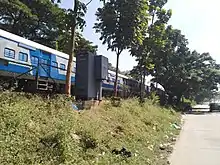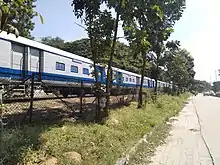Suranjan Das
Suranjan Das (22 February 1920 – 10 January 1970) was a pilot in the Indian Air Force. He joined the Royal Indian Air Force during the Second World War and was among the first pilots to be sent to Empire Test Pilots School to a test pilot for the Indian Air Force. He was a group captain. He commanded the Halwara Air Force Station Base between 1967 and 1969 and was the director of the Aircraft & Armament Testing Group of the Indian Air Force from 1969 until his death. He was awarded the Padma Vibhushan posthumously in 1970.[4] He was the son of Sudhi Ranjan Das[5] He died in an air crash while test flying a HAL HF-24 prototype.[6]
Suranjan Das | |
|---|---|
| Born | 22 February 1920 Calcutta, Bengal Presidency, British India (present day Kolkata, West Bengal, India) |
| Died | 10 January 1970 (aged 49)[1] |
| Allegiance | |
| Service/ | |
| Years of service | 1942–1970 |
| Rank | |
| Service number | no |
| Unit | No. 3 Squadron IAF |
| Commands held | Halwara Air Force Station |
| Awards | |
| Spouse(s) | Veronica Loveless[3] |

The entire 4.1-km stretch of the road connecting Old Madras Road and Old Airport Road, Bangalore, is named Suranjan Das Road after Group Captain Suranjan Das.[3]
References
- Brig S Sunder Rajan (12 February 2020). Personalities Inked: Pen Sketches of known And Some less known faces. Booksclinic Publishing. pp. 29–. ISBN 978-93-89757-51-4. Retrieved 10 July 2020.
- "Group Captain Suranjan Das". Bharat Rakshak. Retrieved 10 July 2020.
- Divya Shekhar (11 February 2016). "Suranjan Das Road: A street named after a legendary pilot". The Economic Times. Retrieved 10 July 2020.
- The Times of India Directory and Year Book Including Who's who. 1970. p. 289. Retrieved 10 July 2020.
- Sainik Samachar. Director of Public Relations, Ministry of Defence. 1970. pp. 226–. Retrieved 10 July 2020.
- Kapil Bhargava. "Suranjan Das - the man and the professional". Indian Aviation. Archived from the original on 18 August 2012. Retrieved 10 July 2020 – via Bharat Rakshak.
